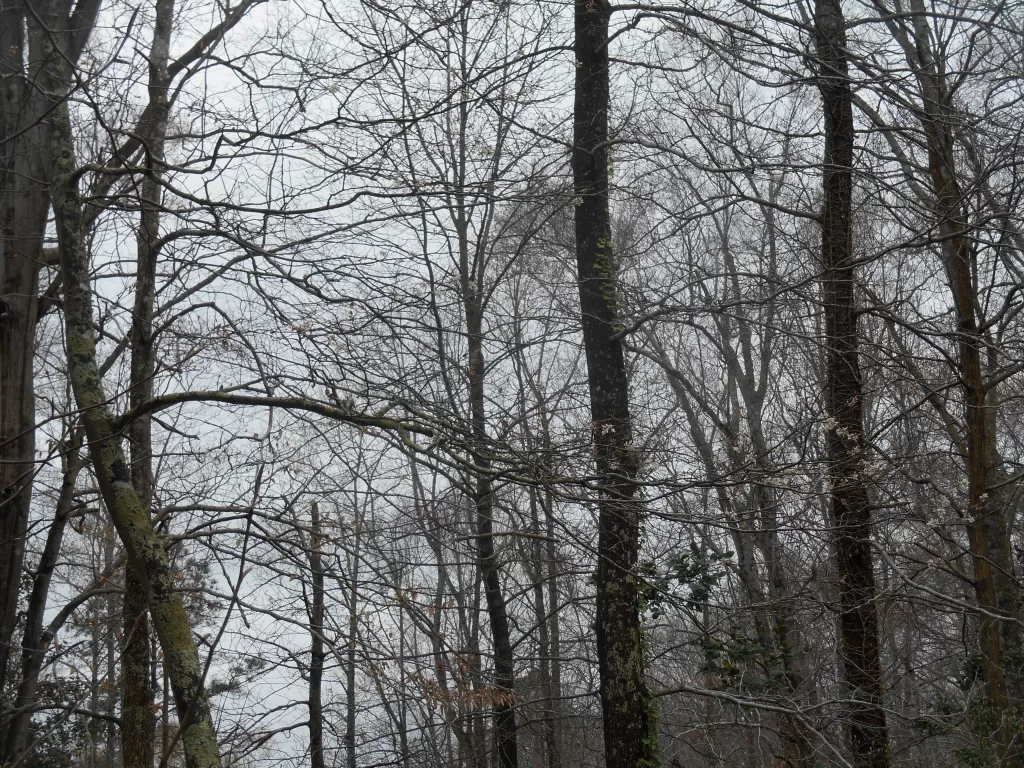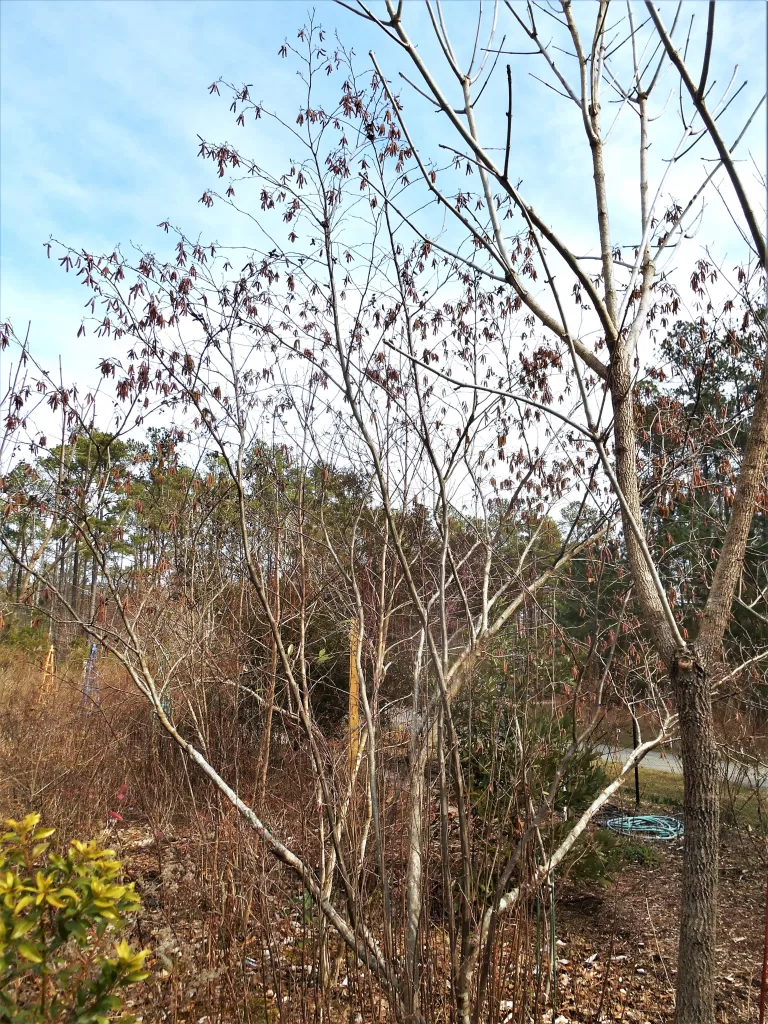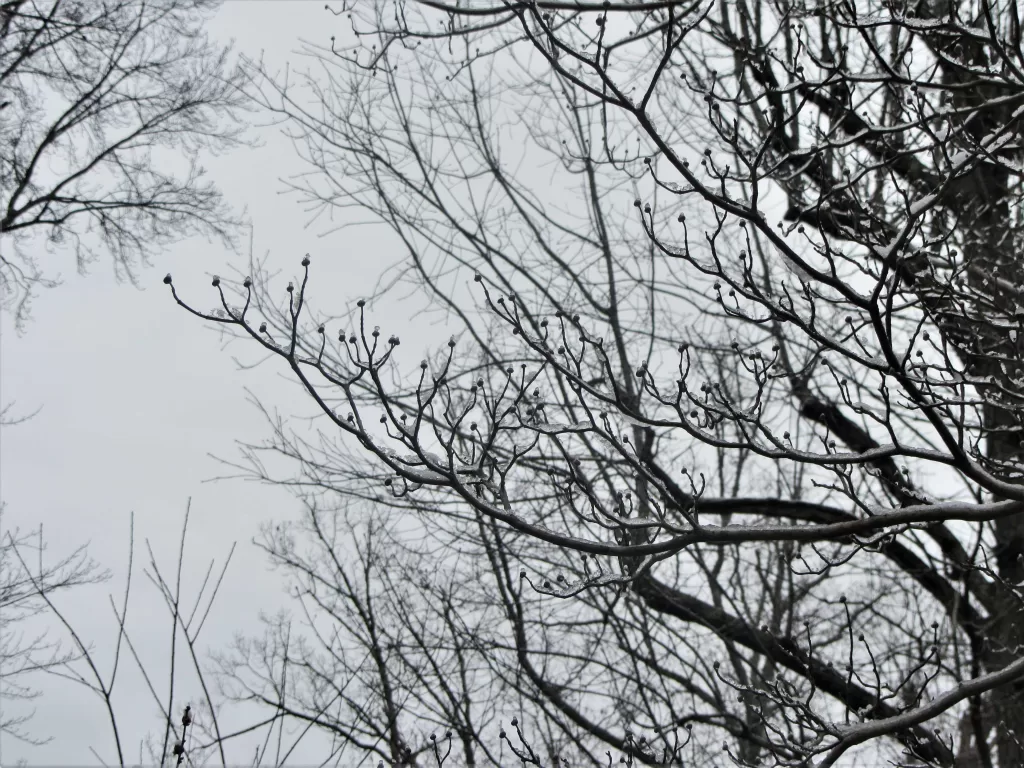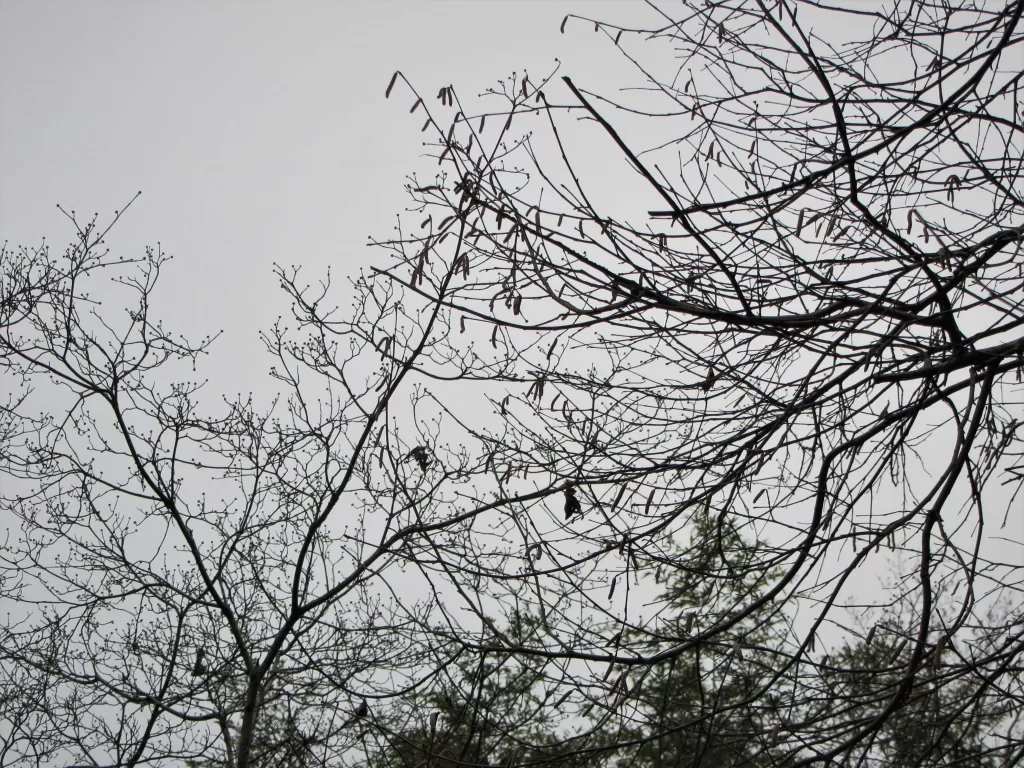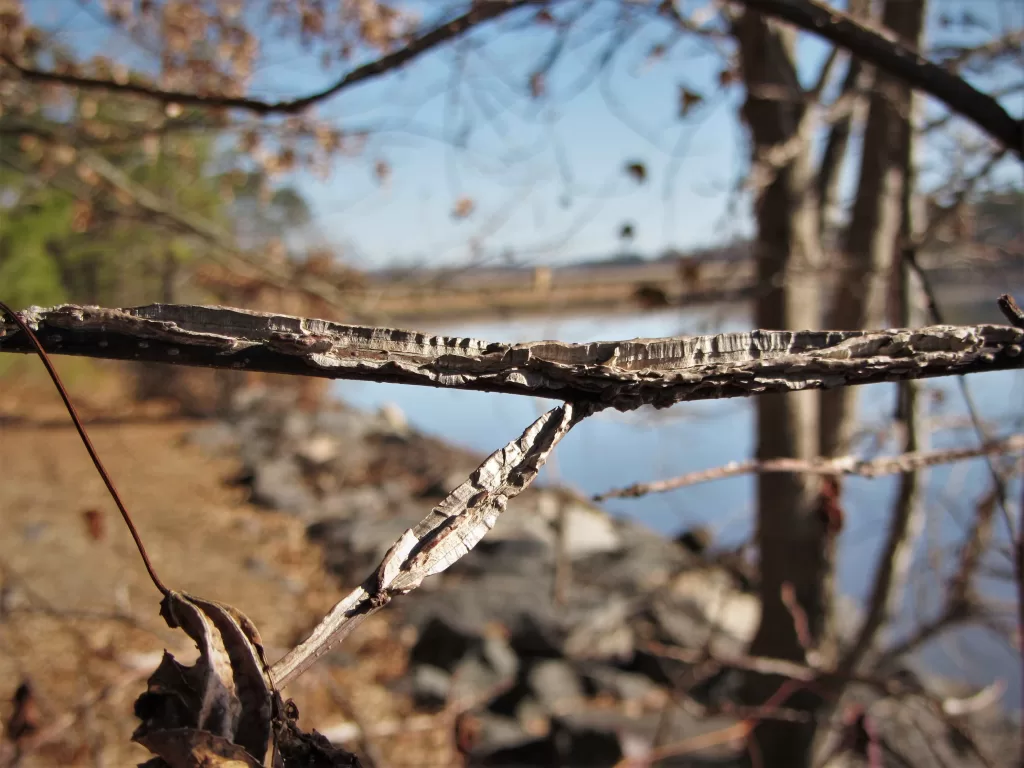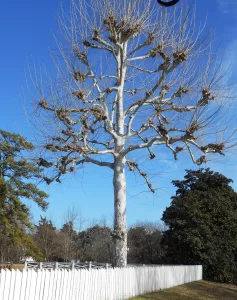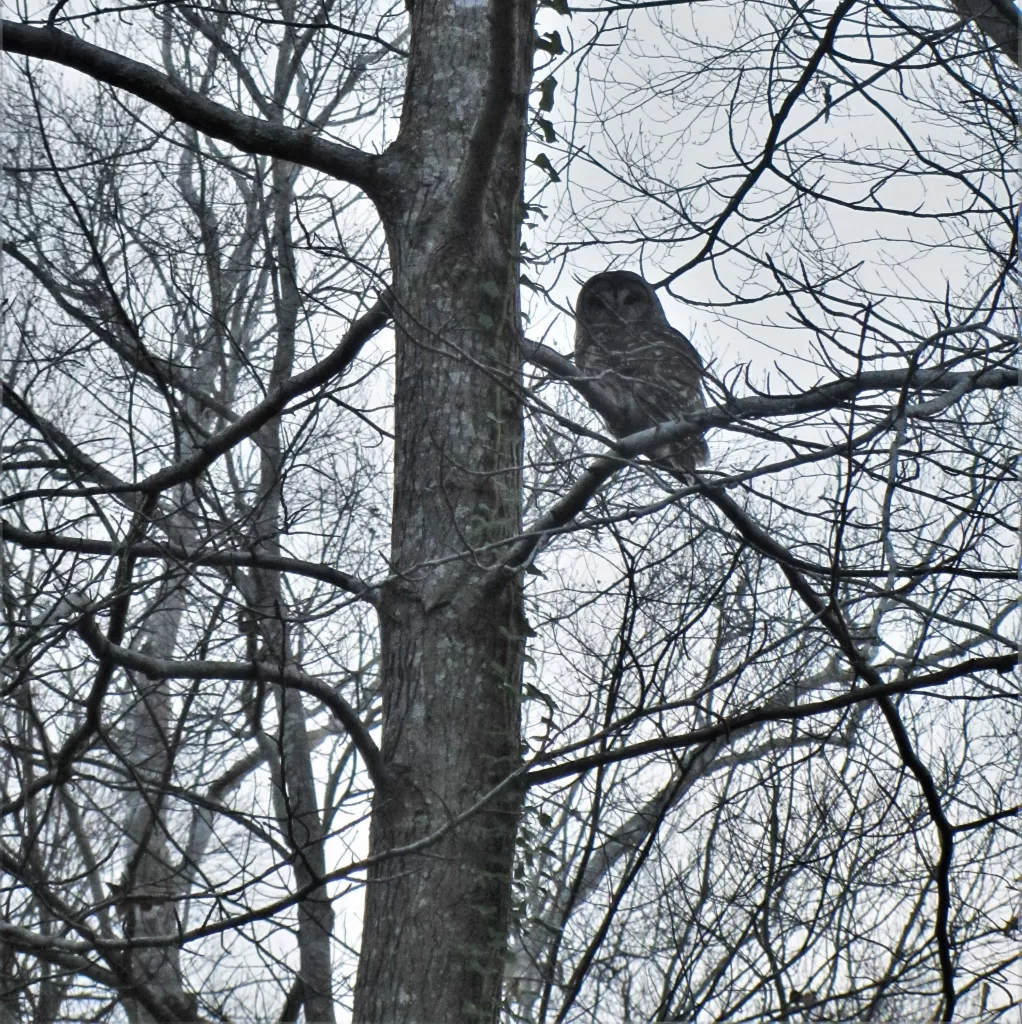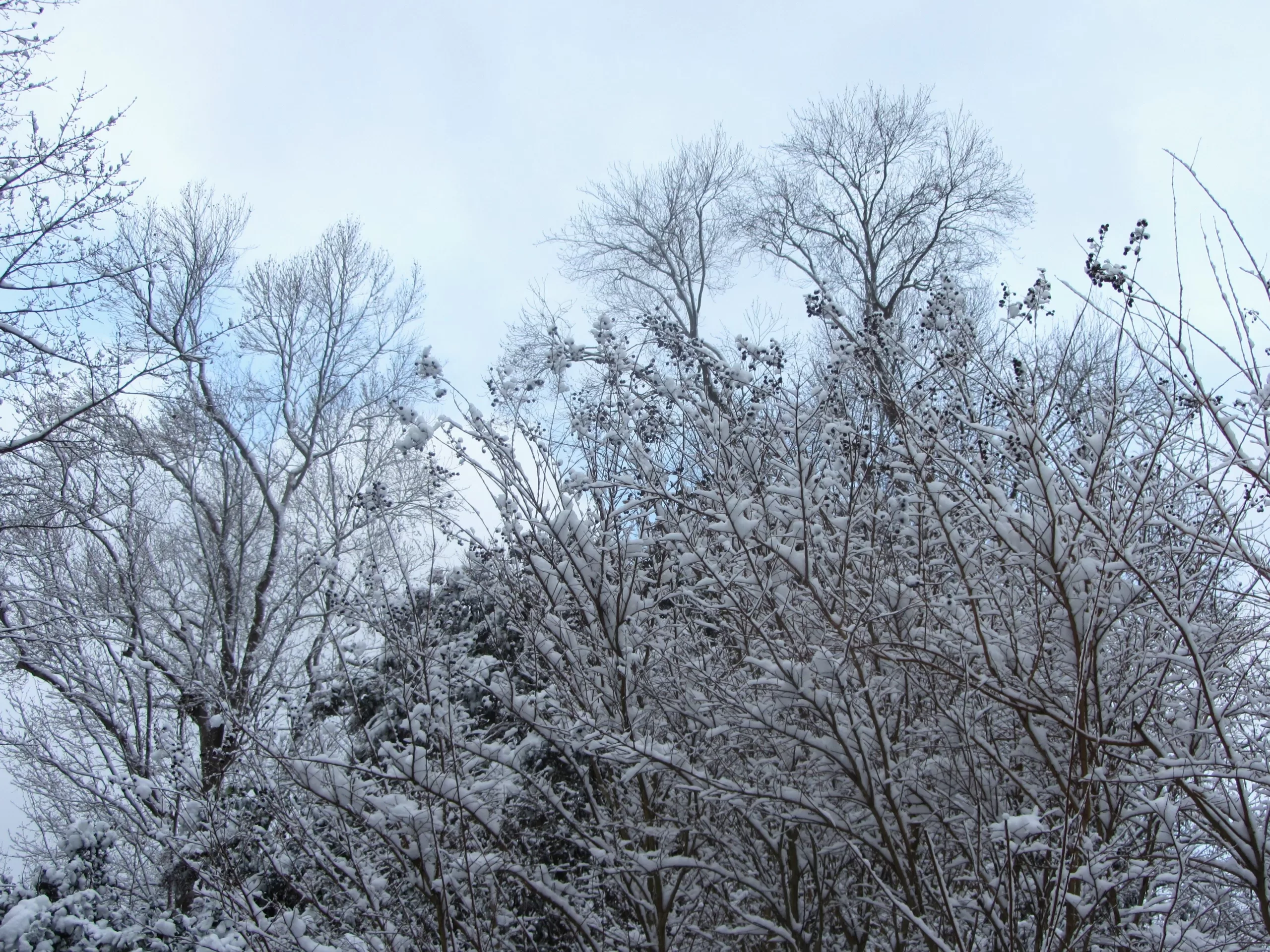The Beauty and Promise of Trees in Winter
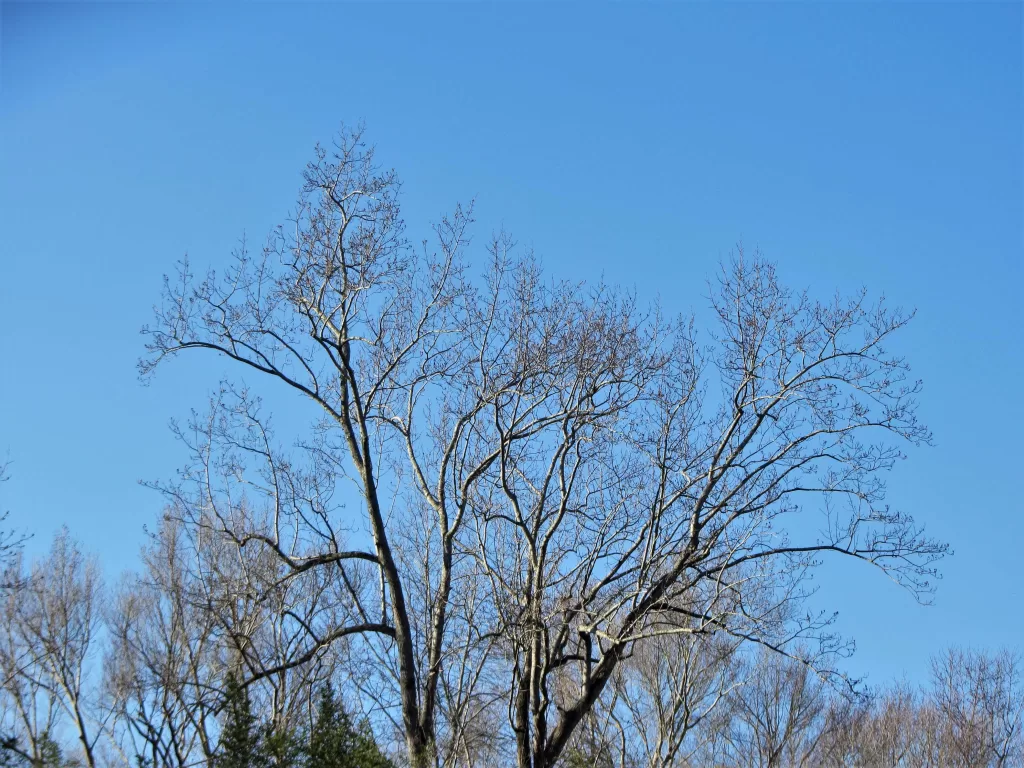
American beech. Nut husks still cling to some of the branches.
There is a special beauty in the form and structure of a bare tree after it has dropped its annual crop of leaves. Like the beauty of a classical statue, one can see the truth of its bones. Leaves, for all of their movement and color, veil the beauty of branches and buds. Looking at a bare tree is a study in pure potential.

Bald Cypress and American Beech trees grow along Powhatan Creek in early December 2016.
All of the tree’s life draws inwards to the wood and roots as it prepares itself to weather another season of freezing cold and winter storms. It has strengthened itself without becoming brittle. It has released its sheaf of ice and snow catching leaves, which would weight it and break it in winter’s icy winds, back to the earth.
Isn’t it ironic that as we add layer upon woolen and fleecy layer to weather winter’s worst days, the trees are shedding their summer garb to survive the months ahead? Left to themselves, the leaves gather and drift into brown and crinkled blankets, insulating and nourishing their own roots.

Lichens and moss enhance the beauty of bark in winter. Various deciduous trees, including the sourwood tree, center right, grow through this stand of loblolly pines. Jamestown Island December 2023.
And those roots hold the life of the tree and the promise of another spring. No matter if branches break or get pruned. Life will flow again in the rising sap come spring, to grow new wood, leaves, flowers and fruits; and to grow farther and taller than ever before. The buds of new life are forming even during the seeming sleep of winter. Look closely, and you’ll see those buds swelling on every twig.
Now, in late December, we return to the season of lacy silhouettes drawn against the ever-changing skies. Perfect algorithms of botanical division and multiplication reveal themselves. Each family of trees reveals its own peculiar geometry and idiosyncratic proofs and promise of the coming season’s growth.
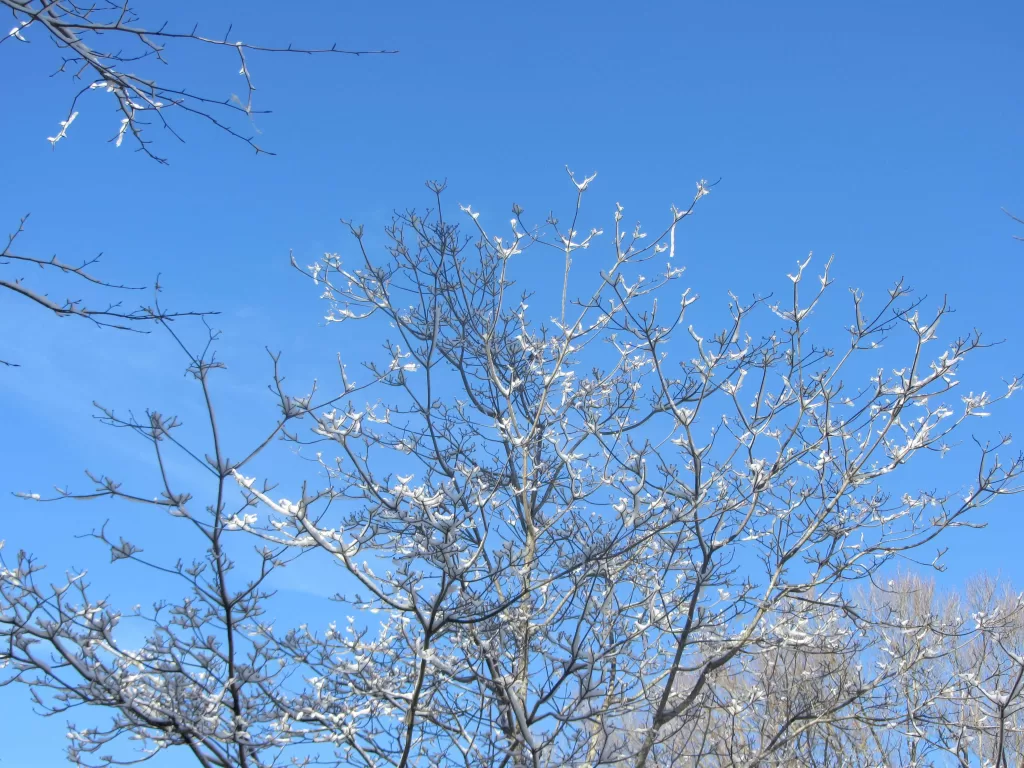
Native flowering dogwood and American beech (left) January 2020.
Seed pods, nuts, fruits, and cones still clinging to twigs guard the seeds of another generation in wait, suspended between autumn and spring, each containing the entire blueprint of the whole encrypted in microscopic biochemical perfection. Like Jonah, many must be swallowed into the belly of a beast before seeing light again, and a chance for germination. The churning through a hungry bird, squirrel, cow, or deer prepares the seed’s coat to absorb water and finally break apart in the warmth of spring, allowing new life to emerge.

American sycamore at Jones Mill Pond along the Colonial Parkway in December of 2022. This tree was removed in early 2023.
Those who know the work of Robert Pirsig may recognize this blurring of science and art, philosophy and living technology. The world is not one or another. It is all. Only in perceiving the all in the one, and the one in the all, do we begin to understand its poetry of perfection.
This is a tale to unravel in winter, when more is revealed to those who look with wonder and understanding. We may notice a maple’s green trunk or branches and understand that it is continuing photosynthesis and growth, even though its leaves have fallen. We may appreciate the textures and colors of exfoliating bark, and the geometry of bark with unique ridge and furrow designs while a tree is bare. We may even marvel at the partnership between tree and moss and lichens.
What follows is a list of particularly interesting deciduous trees with winter ornamental value. We have discussed the winter beauty of evergreen trees in other articles. Now we will consider a few deciduous trees that add particular interest and beauty to our coastal Virginia landscape in winter.
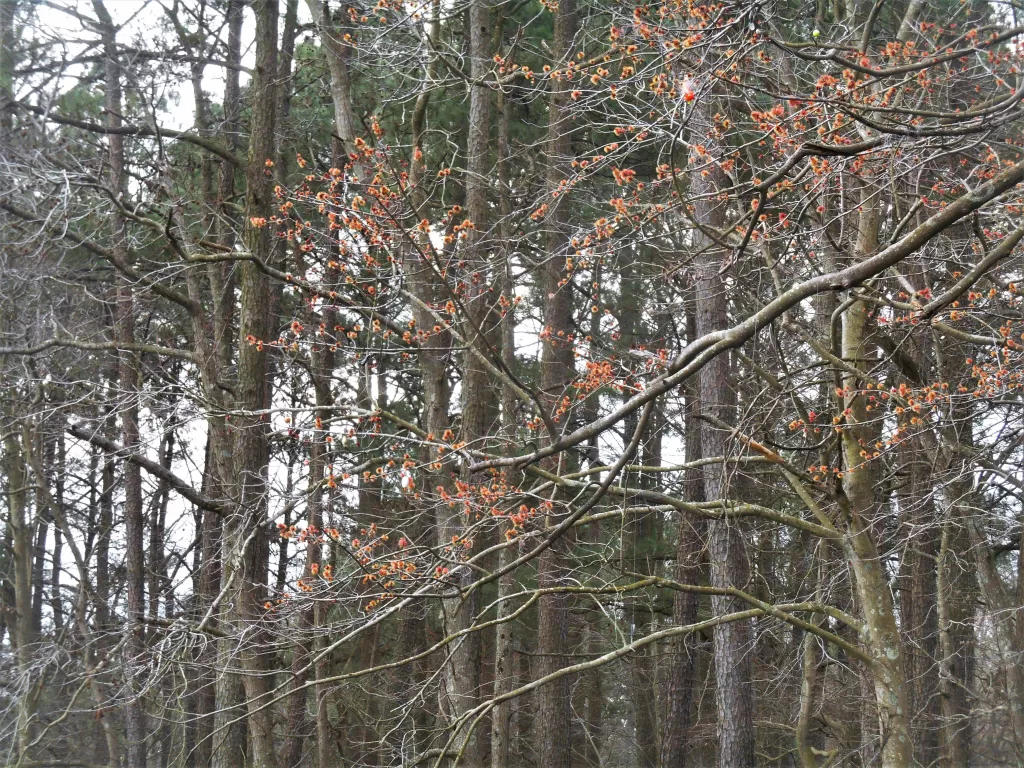
Red maple in bud in late January 2022 at the Newport News reservoir.
Acer spp. Maple: There are many excellent choices in a wide range of sizes from the smallest Japanese maple trees to the largest American red maple, A. rubrum. With more than 132 species, most native to the Northern Hemisphere, plus many hybrids and named cultivars, there will be a maple to fit your space and your aesthetic.

Japanese maple, A. palmatum, late November 2023. Notice how green the bark is on the main branches. That is the color of the bark, not a growth of moss or algae.
While many choose a maple for the size, shape and color of its highly ornamental leaves, a maple’s twigs and trunk may also be colorful during the winter and they bloom in very early spring.
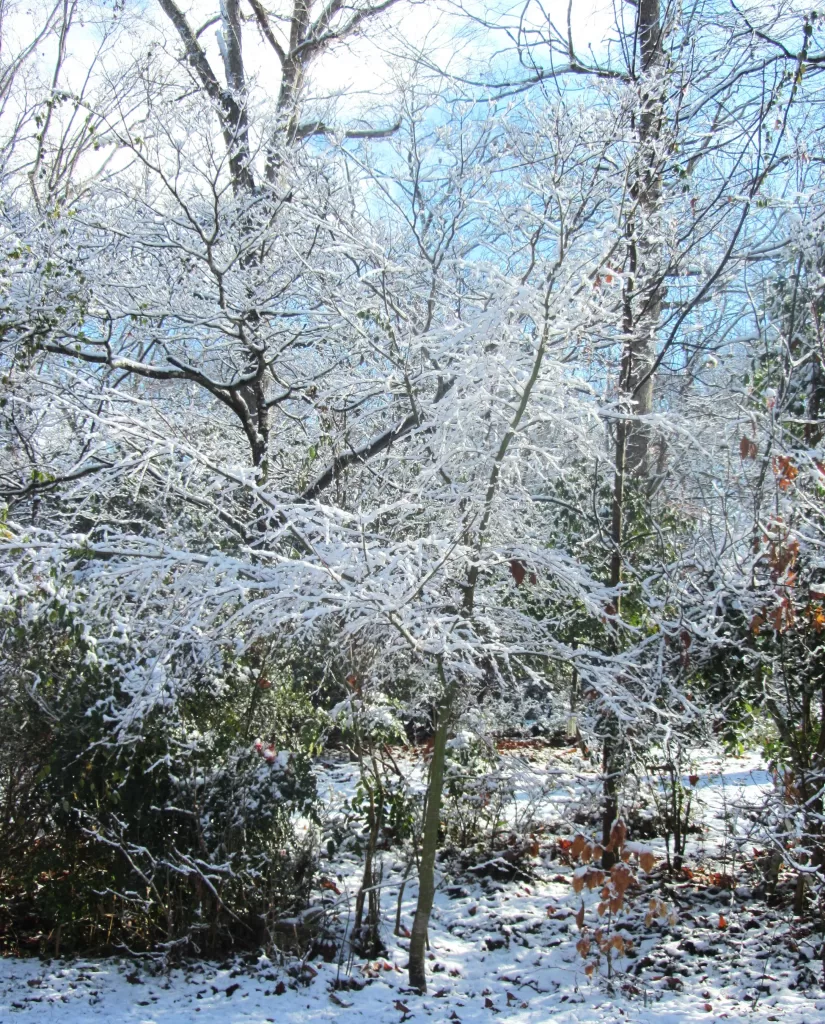
The young Japanese maple in the center (the same tree as above) still has a green trunk and continues to produce food throughout the winter, even without leaves.
A maple’s trunk and stem may also be copper, brown, silver, grey, or burgundy. Maple species from China, Korea and Japan frequently have very elegant and unusual structures. These are very hardy trees with high wildlife value. Check exposure for your chosen tree as many of the ornamental Asian maples prefer partial shade.
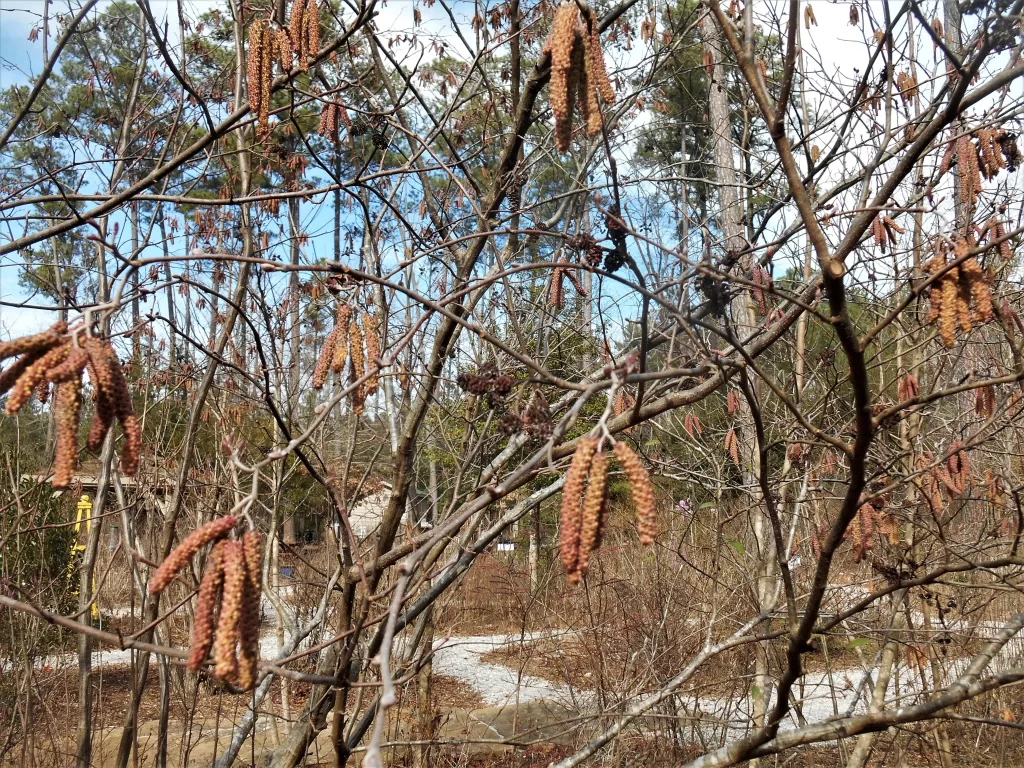
Hazel alder at the Williamsburg Botanical Garden and Freedom Park Arboretum’s wetland in January 2020.
Alnus spp., Alder: Native A. serrulata, hazel alder, prefer wet, swampy or waterfront locations. Like the other 20 or so species of Alnus, they are quick to colonize disturbed land, particularly after fires, landslides, storms, or other events that disturbed the native vegetation. A relatively small, shrubby tree (to 15’), hazel alder, like other members of the Betulaceae family, covers itself in catkins during winter. The female catkins will harden into 1” conelike structures after fertilization and remain hanging on the tree while nut-like seeds ripen. All alders fix nitrogen along their roots, fertilizing the soil for other nearby plants. Bark is smooth and light grey, and this mult-stemmed tree makes an interesting living sculpture in the landscape. All alders have high value for wildlife.
Black alder, A. glutinosa, came to North America with early colonists for use in landscaping and erosion control. This single stemmed, attractive tree grows to 60’ tall and 40’ wide, and tolerates poor soils, wet soils and occasional flooding. Its leaves are glossy green in summer, and its branches and buds provide winter interest in addition to its catkins and lingering cones.
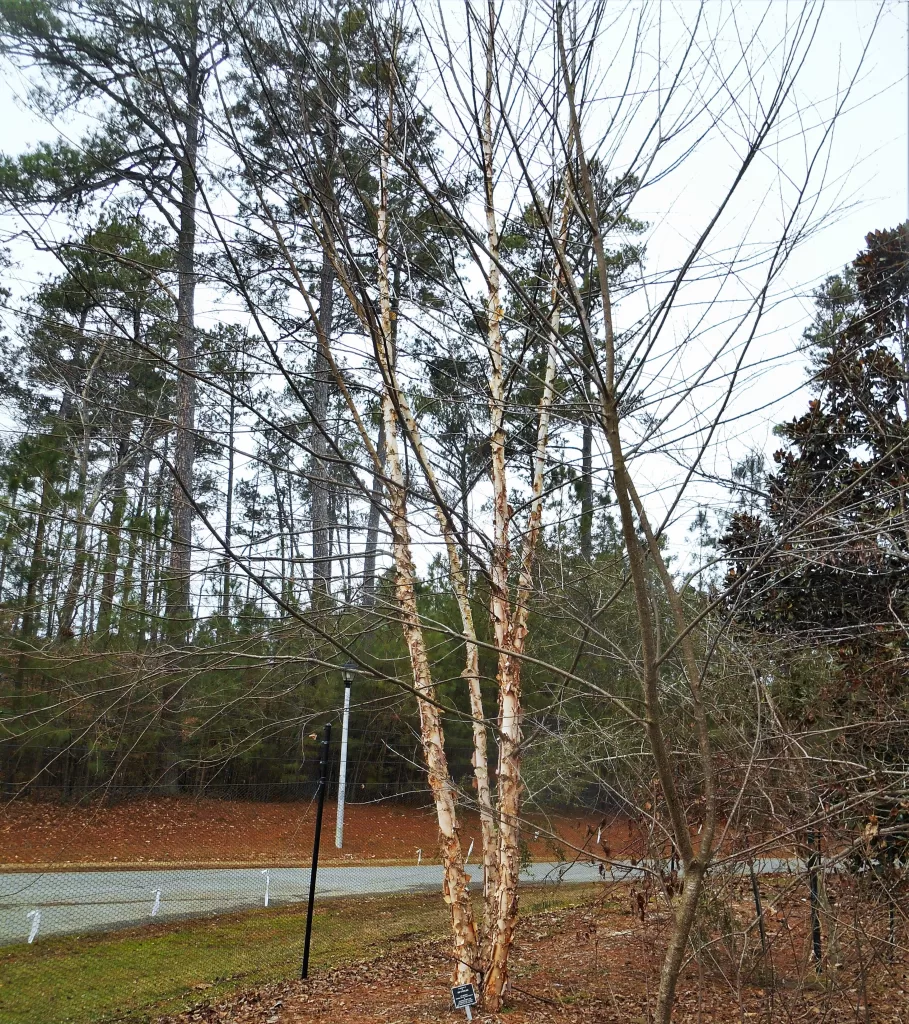
River birch, B. nigra, grows at the WBG-FPA in January 2020.
Betula spp., Birch: Native river birch, B. nigra, and B. papyrifera, paperbark or white birch, are common in our area and easy to spot in a winter landscape because of their textured, exfoliating light colored bark. Like the closely related Alnus ssp., or alders, drooping catkins develop in winter ready for pollination in early spring. Birch trees have a refined and delicate silhouette after their yellow leaves fall in winter.
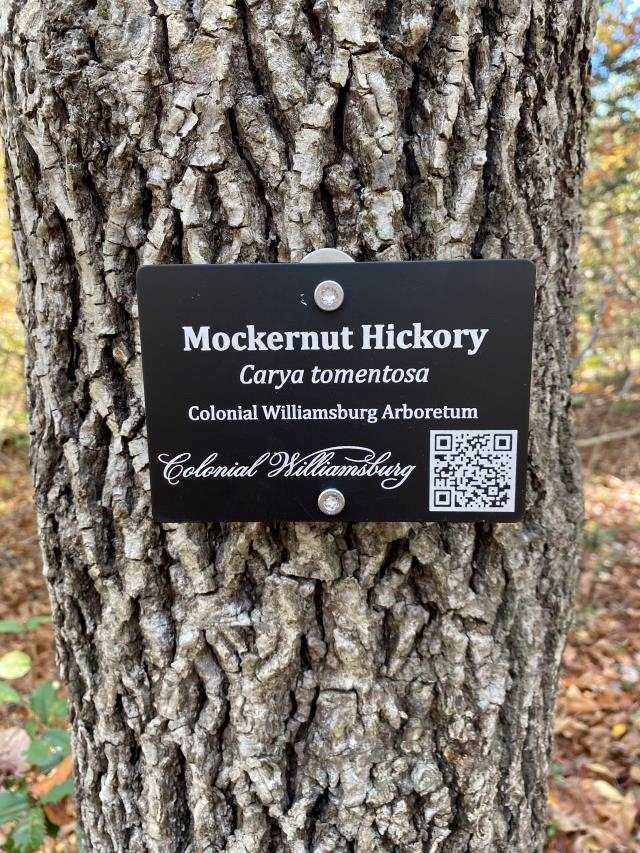
Mockernut hickory bark grows in a series of interlocking ridges and furrows. Photo courtesy of Rick Brown.
Carya spp., Hickory and Pecan: The genus Carya includes at least 18 species of which a third are native to Asia, and the other dozen are native to North America. Carya is a genus within the walnut family and all of the North American species bear edible nuts, some of better quality than others. Young trees may need a decade or more of maturity before they produce nuts.
Pecans, C. illinoinensis, have become a commercial crop in the Southeast for their excellent quality, and these trees perform as a beautifully shaped shade tree in large yards, where homeowners are blessed with an annual crop of nuts. Pecan cultivars grow into huge trees, to more than 100’ high and perhaps 70’ across at maturity. They have huge, spreading branches that may dip down to touch the ground in old age. At least three different cultivars should be planted for pollination and nut production, so either a very large yard, or a group of cooperative neighbors each planting their own tree would be necessary for nut production in a neighborhood setting.
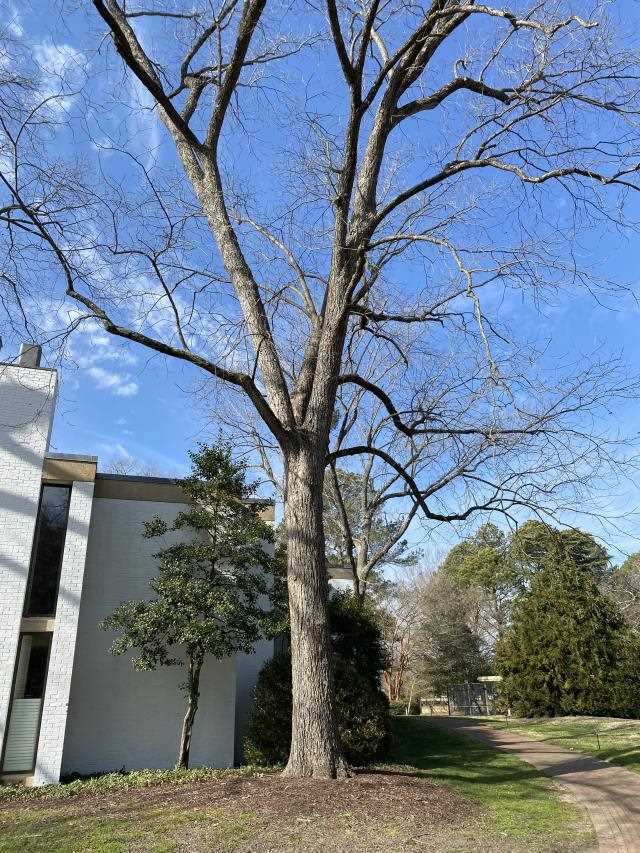
A pecan tree grows adjacent to the Griffin Hotel, Green Wing at Colonial Williamsburg. Photo courtesy of Rick Brown
There are around 7 main hickory species that grow well in our area, but with variable quality of edible nuts. All hickories have distinctive and beautiful bark and interesting branch structures when bare. Mockernut hickory, C. tomentosa, can be easily recognized by the interlacing ridges and furrows in its bark. Its nuts are delicious, but the shells are hard to crack. It grows to around 80’ tall. Shagbark hickory, C. ovata, has unmistakable shaggy bark where long strips may grow to more than a foot long, curling up and away from the trunk, lending a ‘shaggy’ appearance to the tree, which can grow to around 90’ tall. Nuts are excellent. Another hickory with interesting bark is sweet pignut or red hickory, C. ovalis. It is a large tree, to 100’, with a deep taproot and commercial quality nuts.
All hickory trees have high wildlife value because of their nuts, and they also support numerous butterfly and moth species as host plants in summer. These are substantial, hardy shade trees that thrive in a variety of conditions.
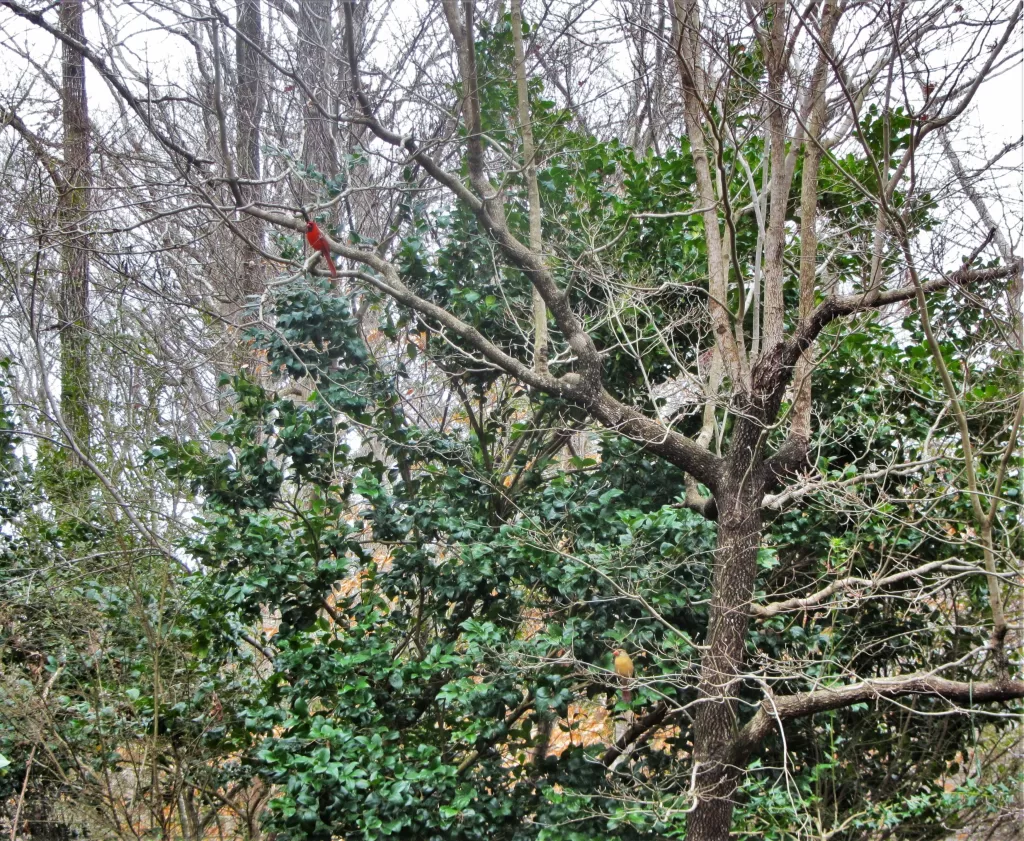
A pair of cardinals rest in a flowering dogwood tree in January 2022. This tree has re-grown new limbs after extensive damage from a fallen oak in 2013.
Cornus spp., Dogwoods: There are more than 30 species of dogwoods, small trees or large shrubs with beautiful branches and twigs, white or pink bracts around tiny insignificant flowers in mid-spring, and drupes in the fall. Their conspicuous flower buds and distinctive twigs make them particularly attractive in winter.
Native C. florida, the common flowering dogwood, is Virginia’s state flower. Its scarlet drupes and autumn leaves make it particularly ornamental, and it attracts many species of birds. There are more than 20 species, hybrids, and named cultivars which grow well in our area. Some have red or yellow twigs in winter. All prefer part sun to partial shade, well-drained acidic soil, and need protection from browsing deer and hungry voles.
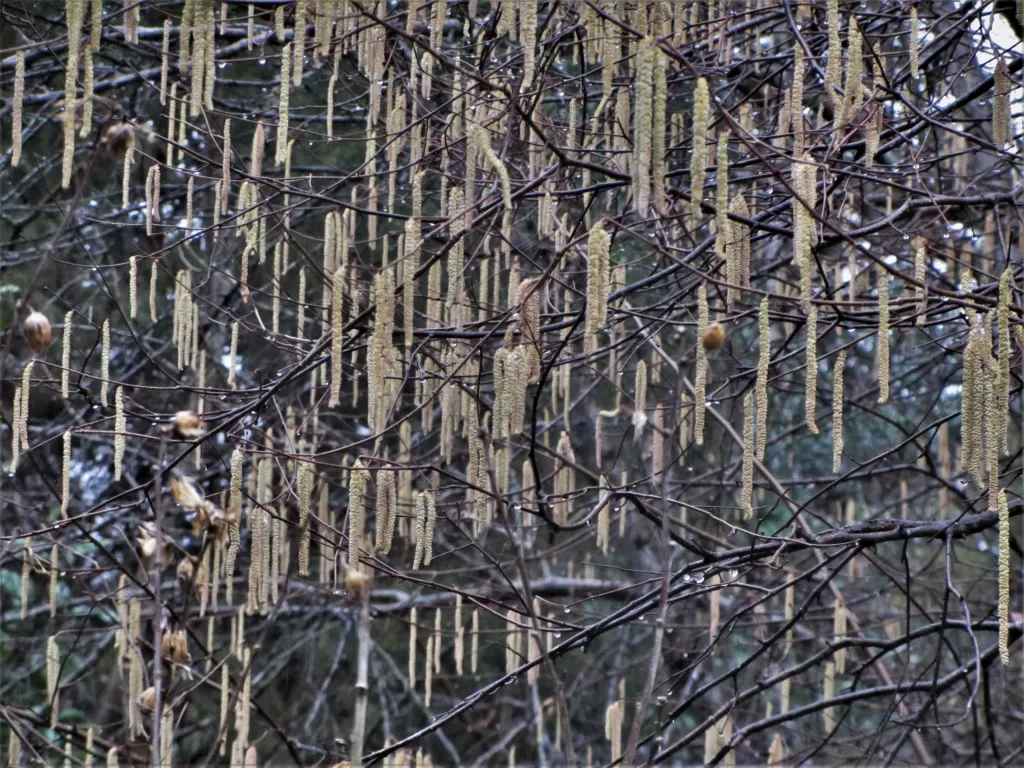
Catkins develop on an American hazel thicket in February 2022. A few shells remain from the previous year’s nuts.
Corylus spp., Hazel: A member of the birch family with around 30 species world-wide, hazel trees all produce edible hazel nuts. The most outstanding winter feature of this tree are its male, pollen bearing catkins which begin to form during the winter, growing longer each week in preparation for pollination in the spring. Both male and female flowers develop on the same tree. American and European species, like our C. americana, are multi-stemmed, suckering trees that will grow to perhaps 12’ tall. They grow well on slopes and hillsides, make excellent windbreaks in pastures, and form thickets over time. Individual stems may be coppiced to use for making things, like fences and trellises, about every seven years, and the plant will quickly replace harvested stems.
There are four basic species commonly grown in our area. The American hazelnut, European filbert, the beaked hazelnut, and the Chinese hazelnut. The Chinese hazelnut is a single trunk tree with beautiful exfoliating bark in shades of cream and cinnamon. It grows to perhaps 50’ and was introduced to the United States in 1996.
The European filbert has the habit of forming twisted, contorted branches and may be sold as ‘Harry Lauder’s Walkingstick’ for its unusual, sometimes drooping form. It grows to perhaps 10’ tall and wide and wants partial shade. All of these trees have high wildlife value throughout the year. Hazel branches and hazel nuts figure prominently in myth, magic and folklore. Hazelnuts are said to give great wisdom. Hazel branches are used for dowsing and divination. Young dormant branches will take root in moist soil during the winter and grow into new trees.
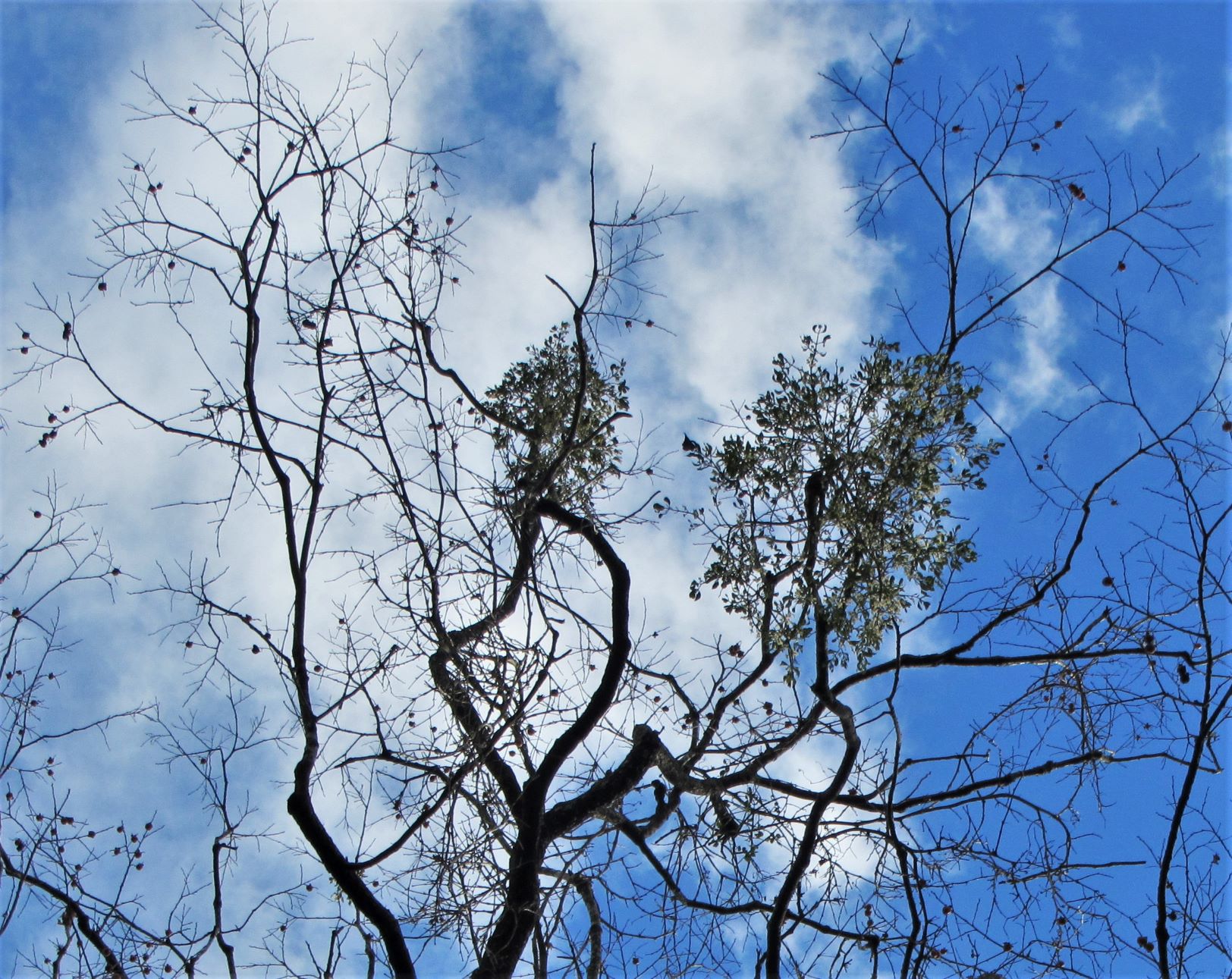
American mistletoe grows in an old American persimmon tree on Jamestown Island. Fruits still cling to the tree after its leaves have fallen. November 2022
Diospyros virginiana, American Persimmon: Persimmon fruits ripen in late fall on female trees and develop their best flavor after frost. Small, orange edible fruits cling to the branches long after this tree’s golden leaves have fallen. Fruit, bark, and interesting branch structure make this native tree endlessly fascinating in winter. It is said to have ‘alligator bark’ for the dark, blocky scales that develop on mature trees. Trees may grow to 80’ and 35’ wide in a good location with sun. Trees grown in part shade may become shrubby and grow to only around 15’-20’.
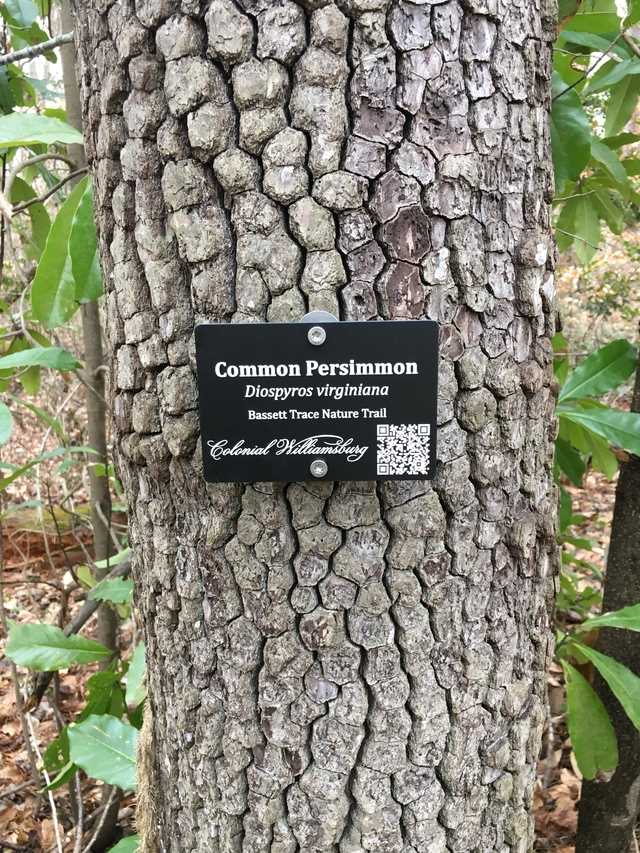
This American persimmon grows wild along the Bassett Trace Nature Trail in the woodlands behind Bassett Hall. Its ‘alligator bark’ makes it particularly interesting in winter. Photo courtesy of Rick Brown.
Persimmon trees have deep taproots and so don’t easily transplant. They tolerate poor soils, heat and drought, air pollution, high winds, and will grow in partial shade. The prefer moist but well drained soils and grow extremely well on slopes, where they hold the ground. Best fruiting occurs in full sun.
Every fruit bearing female tree needs her mate for pollination, so make sure to plant more than one tree unless other persimmon trees grow nearby. It may take nine years for a tree grown from seed to fruit and there is no way to tell one gender tree from another until they bloom. Persimmon trees grow easily from cuttings. Trees grown from cuttings taken from female trees will produce fruit within three or four years when there is a male pollinator nearby.

American persimmon branches frequently grow with odd bends and twists, sometimes weeping, adding character to the tree’s structure. November 2022, Jamestown Island.
Persimmon trees were an important food source for Native Americans and the early colonists. Their unripe fruits and inner bark were used medicinally, and persimmon wood is particularly hard and rot resistant. The genus Diospyros is a member of the Ebony family, so the wood, seeds and bark are very dark. Fruits of the North American native persimmon are much smaller than those produced on the Asian persimmon, D. kaki. Japanese persimmon trees are smaller, to 30’ tall and wide, and their leaves are used to make tea. Persimmons sold at grocers are usually the Asian variety. Hardy in Zones 7-10, Asian persimmon trees grow well in our area and may be more suitable in smaller yards.

American Beech, late February 2022.
Fagus spp., Beech: Native to North America and Europe, beech trees are admired for their tall, straight trunks clothed in very smooth light grey bark. Their trunks shine like beacons in the winter landscape. American beech, F. grandifolia, and European beach, F. sylvatica, both grow well in our area and are widely used in parks and other public plantings. These large shade trees are very sturdy and long-lived. Their edible nuts also feed a variety of wildlife. Long, pointed leaf buds provide extra interest in winter alongside dried, coppery leaves lingering from the previous season.
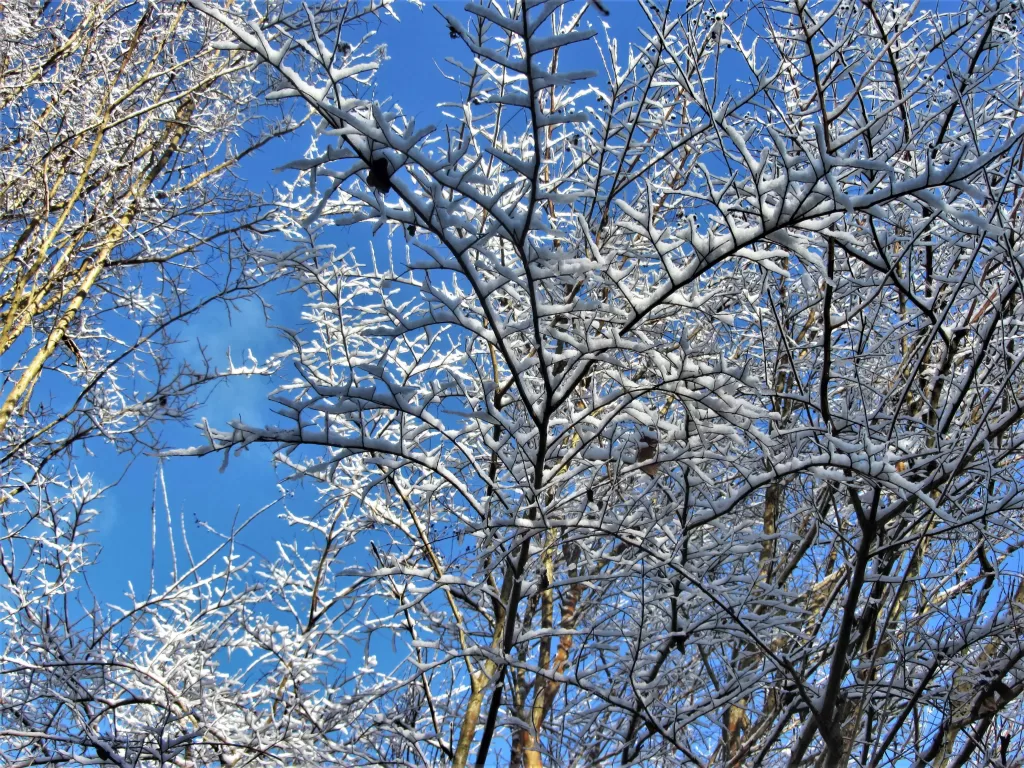
Crape myrtle branches have a fine, lacy texture. Seed capsules persist through the winter, attracting hungry birds. January 2022
Lagerstroemia indica, Crape Myrtle: Normally considered a summer flowering tree that remains in bloom over several months during the hottest part of the year, crape myrtle’s elegant trunks and branches, beautiful exfoliating bark, and seed capsules add distinctive structure to the winter landscape. Trunks are slender, textured, and covered with light tan, brown, grey, or cream colored thin, very smooth layers of bark which peel off in sheets as each trunk expands in diameter. Crape myrtle may be grown as a large clumping shrub, a multi-stemmed or single-stemmed small tree. Crape myrtle seeds attract birds throughout the winter.
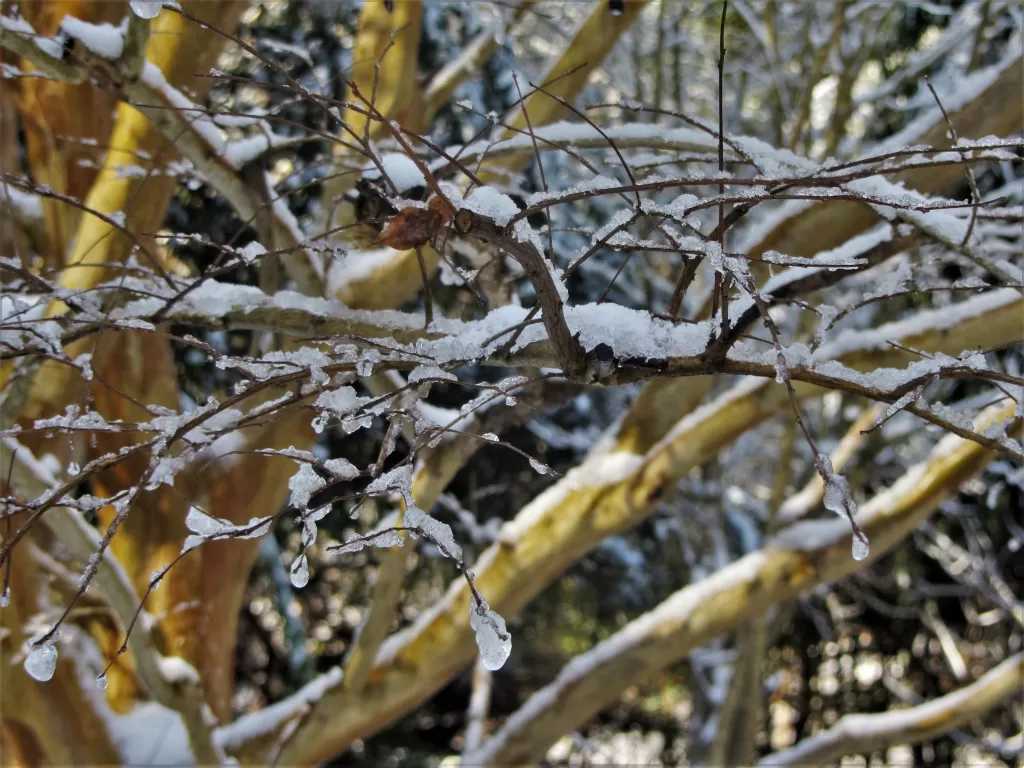
Crape myrtle has beautiful, exfoliating bark in winter. Prune carefully to maintain the tree’s elegant structure.
Avoid the temptation to prune with a chainsaw, as some have done, to perform annual ‘crape murder.’ This pollarding practice helps control the size of the tree but totally spoils its form and silhouette. Crape myrtle blooms on new wood, and the stress of growing new branches from pollarded stems forces the tree to produce many new, spindly flowering branches from each cut. The tree ends up looking like a lollipop instead of a graceful tree. Instead, prune selectively in February to remove damaged or crossed branches, remove old seed heads that are within reach, and thin out any congested areas in the canopy of the tree using good pruning practices to shape the tree.
This is a tough tree that grows in a variety of conditions, but blooms best in full sun. It is frequently grown as a ‘street tree’ in urban environments. After decades of selection and hybridization of this Asian species, there is a wide variety of sizes, forms, flower and leaf colors available to fit almost any landscaping need. This tree has naturalized in our area yet is not considered invasive.
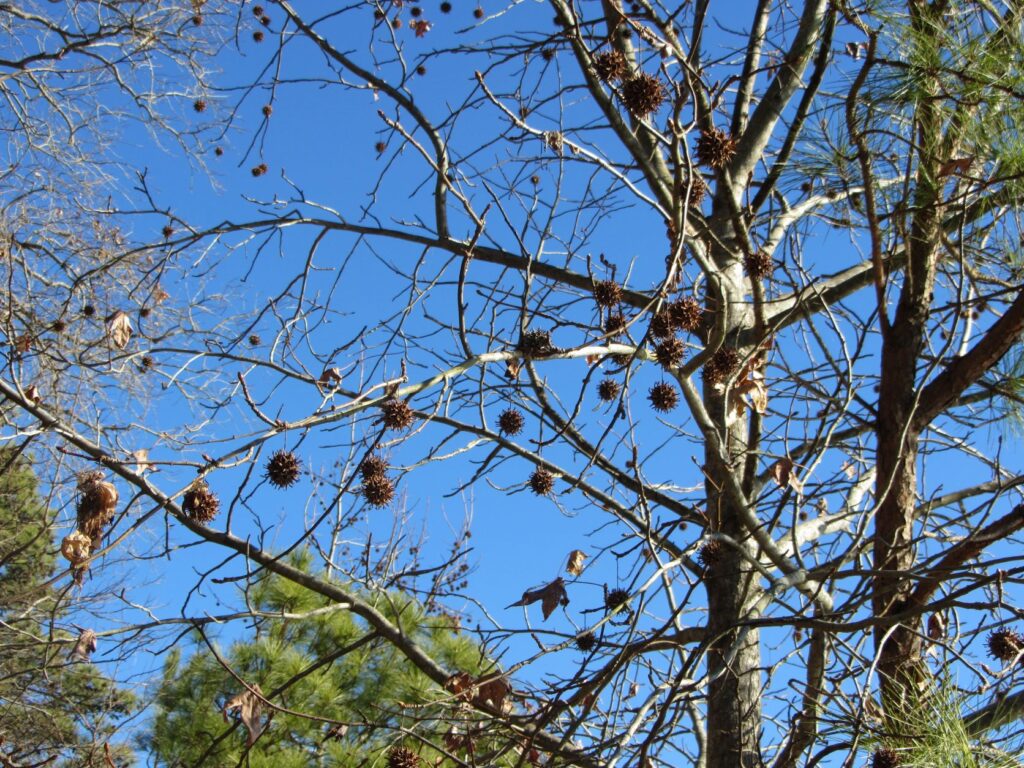
American sweetgum, Liquidambar, holds some of its fruits through the winter. This tree is an important food source for wild life. January 2022 beside the James River.
Liquidambar styraciflua, American Sweetgum: While this tree is best known for its round, cone like fruit, the corky ‘wings’ on its twigs and small branches prove most interesting in winter. Bark is corky and forms in thick plates separated by deep furrows. Twigs are reddish brown and leaf buds prominent in winter.
Bark is an important food source for some animals in winter. This sturdy, adaptable native tree grows to 100′ tall and 50′ and can tolerate wet soil, occasional flooding, and grows well along waterways. It has high wildlife value and intense autumn color. Its reddish, gummy sap is edible and the source of its common name.
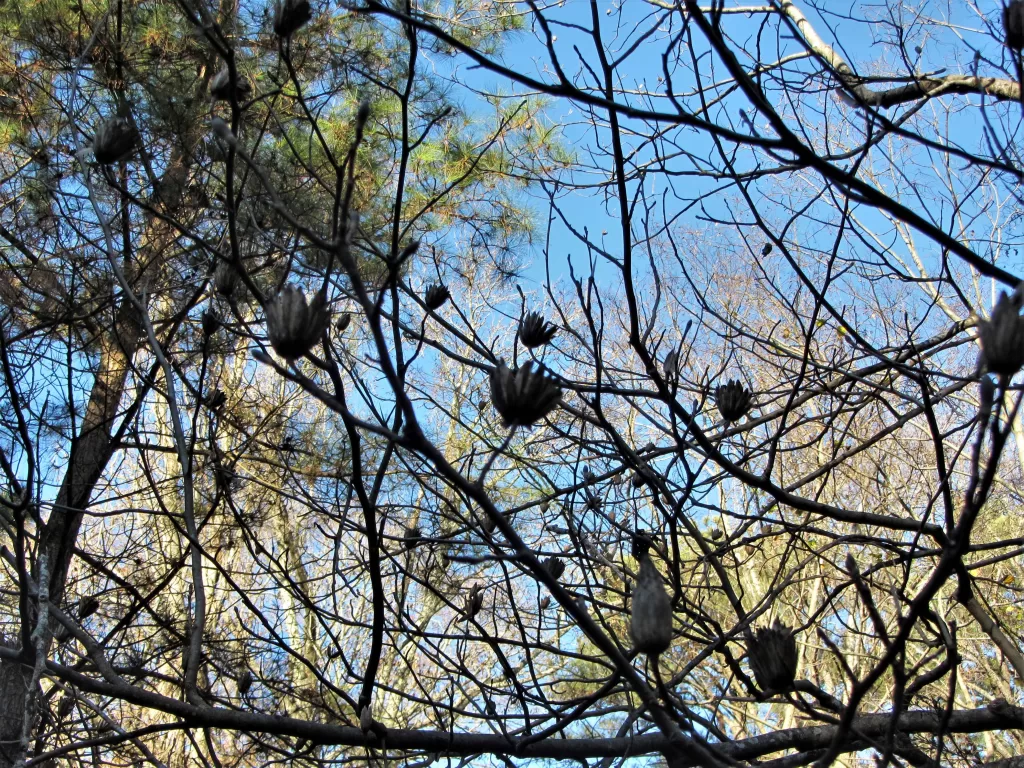
This tulip poplar growing on Jamestown Island still holds both open and closed woody fruits in February 2022.
Liriodendron tulipifera, Tulip poplar or tulip tree: One of the largest trees in North America, growing to 120’ or more, this is another tree with smooth, light grey bark. As the tree ages, bark becomes thicker and wide, white furrows between flat ridges develop. The trunk may grow to 6’ in diameter with age. Cone or flower shaped woody fruits cling to the branches through the winter. Once the cones open to release their winged seeds, they take on a ‘tulip-like’ appearance. Long, plump leaf buds resemble a duck’s bill. Spring flowers also look like tiny yellow and orange tulips clinging to the branches. They attract a variety of pollinators, including hummingbirds. The entire tree has high wildlife value and is interesting in all seasons.
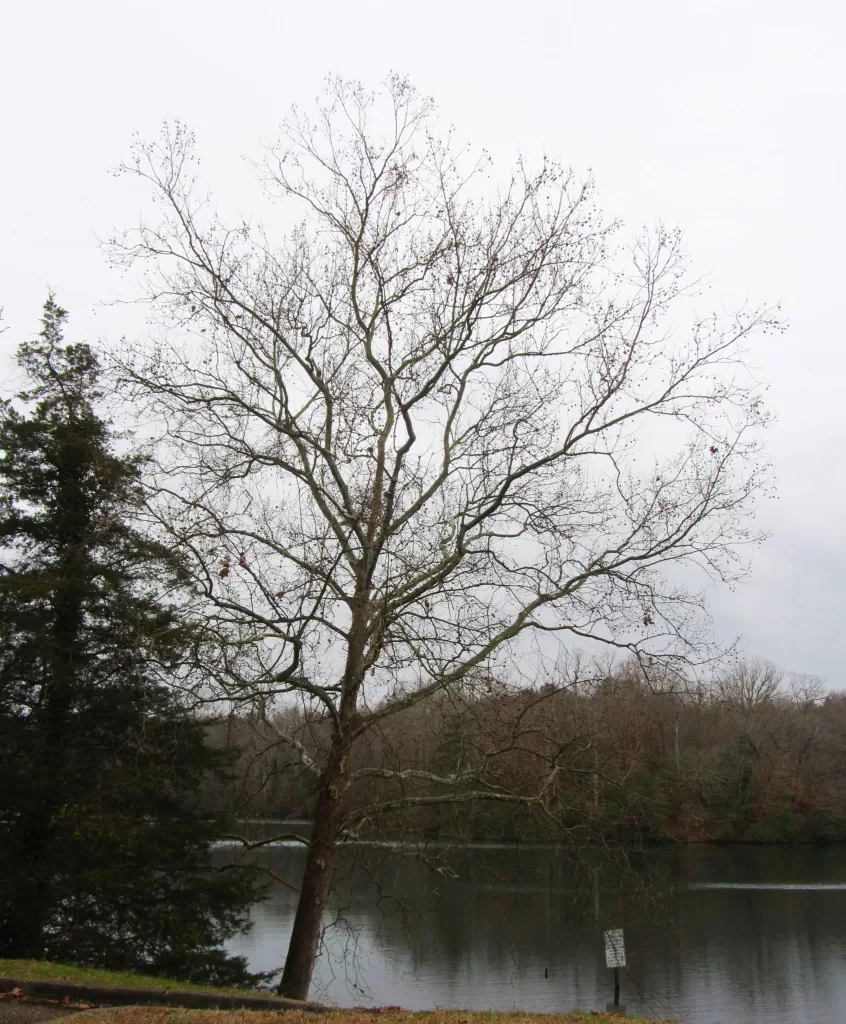
American Sycamore at Jones Mill Pond in December 2022.
Platanus occidentalis, American Sycamore: One of the largest deciduous trees in North America, sycamore has beautiful, exfoliating bark, a graceful form, and the winter interest of round fruits which hang from its branches deep into the season. Bark is mottled with white and silvery patches. Branch structure is elegant and becomes wider and more open as the tree ages. It has such a large trunk that it was favored by native Americans for making canoes. They used sheets of bark for making household items.
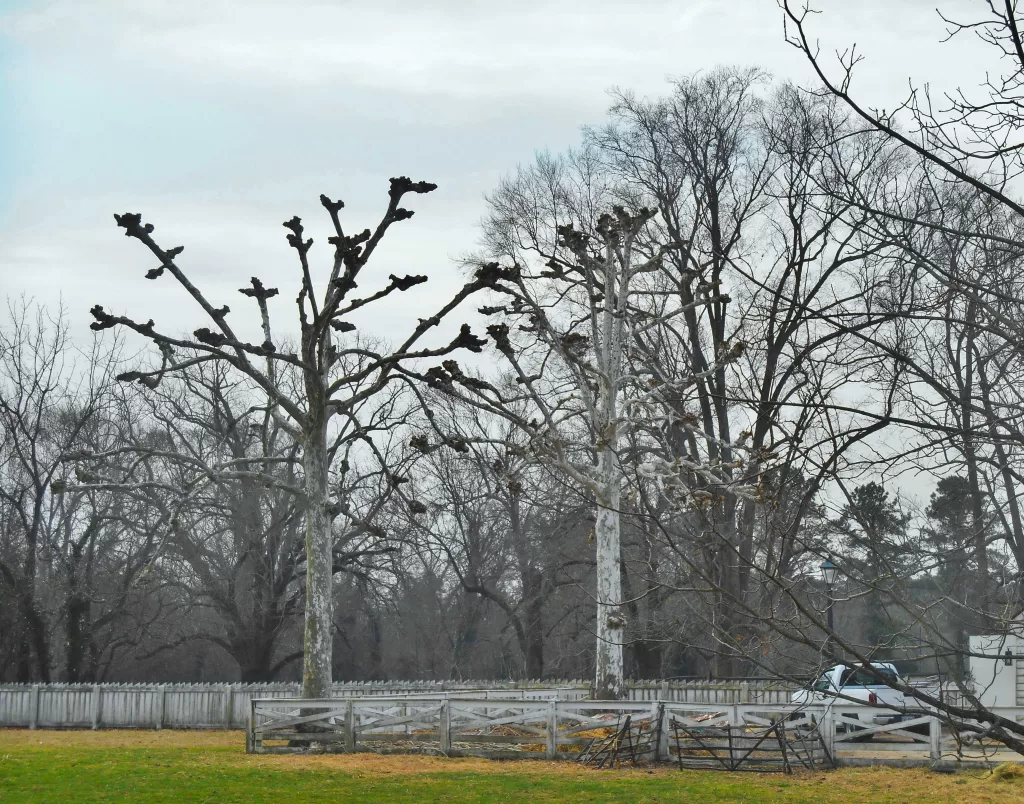
Two pollarded American sycamores grow in the rear of the Taliaferro-Cole lot just off Nassau Street in Colonial Williamsburg. By mid-March, the previous year’s growth has been pruned away to prepare for spring growth. March 2014.
P. x acerifolia, the London planetree, is a possibly accidental hybrid between P. occidentalis, native to North America, and P. orientalis, native to southern Europe and Asia. It probably dates to the 1640s and was first documented in 1789. It looks similar to the American sycamore, but its fruiting balls occur in pairs and its leaves have deeper sinuses. London planetree grows well in the challenges of an urban environment and has been used extensively as a ‘street tree’ in large cities.
These pollarded American sycamores have sometimes been mistaken for the London planetree, but are in fact native P. occidentalis. P. orientalis, the species more common in Europe, can be seen growing in Merchant’s Square and at the downtown Williamsburg Public Library.
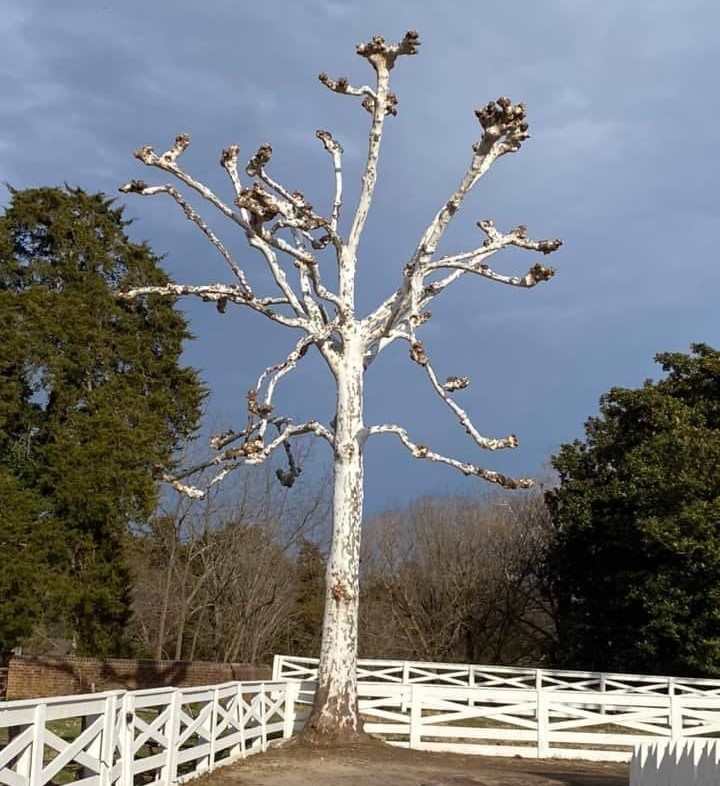
This American sycamore in the rear of the Taliaferro-Cole lot at Colonial Williamsburg is pollarded each spring. All new growth from the previous year is cut away, leaving in knob at the end or each branch where new growth will emerge when the tree breaks dormancy. This is a European style of pruning used to control the size of a tree. Photo courtesy of Rick Brown.
Ulmus parvifolia, Lacebark elm: An excellent substitute for our native elm trees which have been devastated by Dutch elm disease, this Asian elm species is known for its lacy, exfoliating bark.
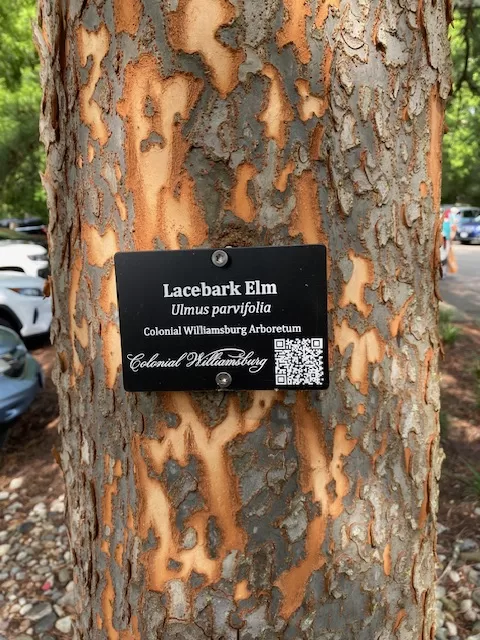
Lacebark elm, Ulmus parvifolia, grows in the parking lot of the Williamsburg Inn Tennis Club, adjacent to the Griffin Hotel at Colonial Williamsburg. This is a beautiful street tree that can withstand exhaust and other air pollution. Photo courtesy of Rick Brown
Native to China, Japan and Korea, Chinese, or lacebark elm is a fast-growing upright tree that prefers well-drained soil, but it can grow in wet areas that occasionally flood. It is somewhat salt tolerant. It will grow to around 60’ in sun to part shade. While this elm is not vulnerable to Dutch elm disease and tolerates air pollution, it is not dependable in high winds. Otherwise, it is an excellent street tree in cities and neighborhoods.
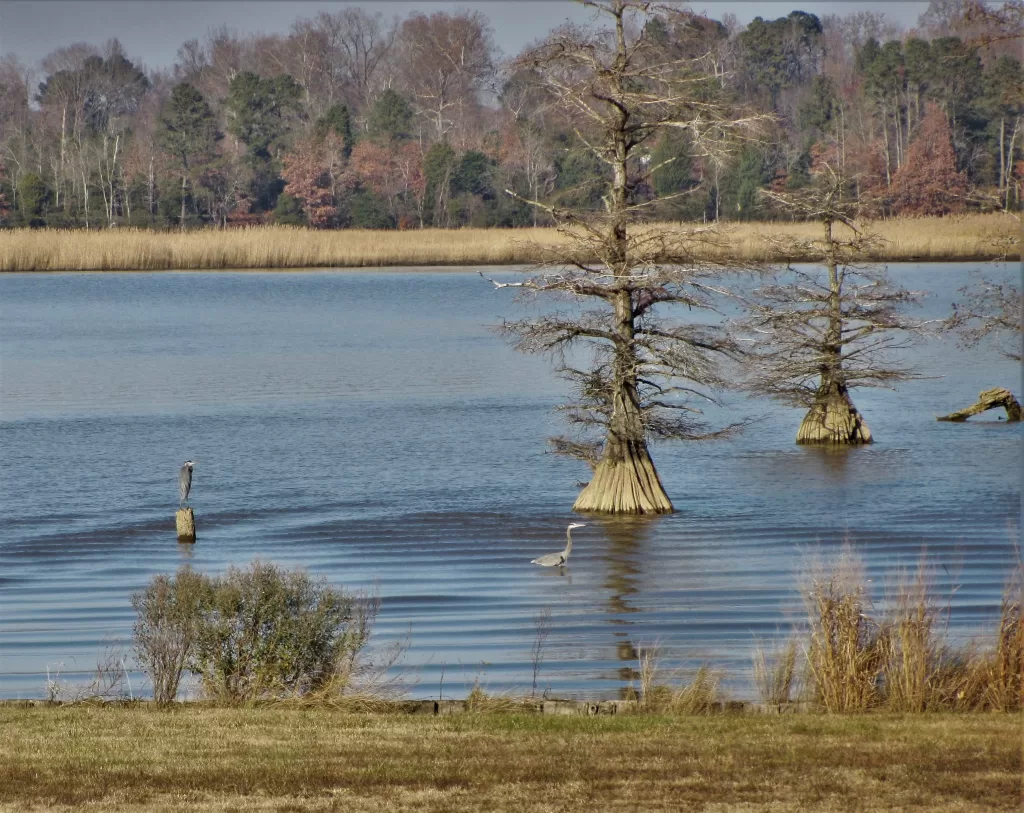
Bald cypress trees grow in Sandy Bay near Jamestown Island. Great Blue Herons, Osprey Eagles, and Bald Eagles perch in the tops of these trees while in search of food on the waters below. Eagles will build their nests in the top of a bald cypress trees.
Taxodium distichum, Bald cypress: An ancient tree, this deciduous conifer grows best in shallow water or damp places that regularly flood. Native to our area, bald cypress is a distinctive presence in our wetlands, parks, and waterfront neighborhoods. It has some salt resistance and will grow in brackish water. This very tough, long-lived tree eventually grows to 50’-70’ tall and 30’ wide at its canopy. Its base may grow to 10’ wide below the trunk as its distinctive knobby ‘knees’ develop, particularly in shallow water.
These specialized roots help the tree’s roots to ‘breathe,’ while also adding to the distinctive beauty of this species. Stringy, exfoliating bark found many uses among native Americans. Faded leaves cling to the tree’s branches for some weeks before eventually falling. Cones are relatively small, develop in clusters and ripen in the fall. The dense, fine branch structure make this tree particularly beautiful in silhouette against a winter sky.
Winter is the best time of the year to care for deciduous trees as well as to appreciate them. Bare branches allow us to examine a tree’s structure and complete any needed pruning and removal of vines while the tree is dormant. Always use sharp clean secateurs, saws, and loppers to avoid spreading disease. Lysol disinfectant is effective for quickly cleaning blades between trees and after removing any diseased branches.
Pruning should correct any developing problems like crossed branches, stems growing back in towards the middle of a tree, and any broken, damaged, or diseased branches. Always cut back to just above a bud, or completely remove a branch where it grows from a larger branch. Regular observation of a tree’s growth pattern, and quick correction as soon as problems develop, improve the beauty and health of trees, particularly in winter.

Native trees grow along the banks of the James River in early December 2023. The coppery trees are bald cypress that have not yet dropped their leaves for the winter.
“The more you look, the more you see.”
Trees contribute to the beauty of our yards and support our ecosystem throughout the year, even while they are dormant. They feed and shelter wildlife, hold and enrich the soil, and stand firm against winter winds. Winter allows us to appreciate the subtlety of their colors and form when we venture outdoors in search of beauty.
All photos by E. L. McCoy unless otherwise attributed.
With much appreciation to Rick Brown, Master Gardener Tree Steward and Colonial Williamsburg volunteer
for his assistance with this article and for generously sharing his photos.
Learn more about pruning techniques and tools from these videos produced by local Master Gardeners.
.

